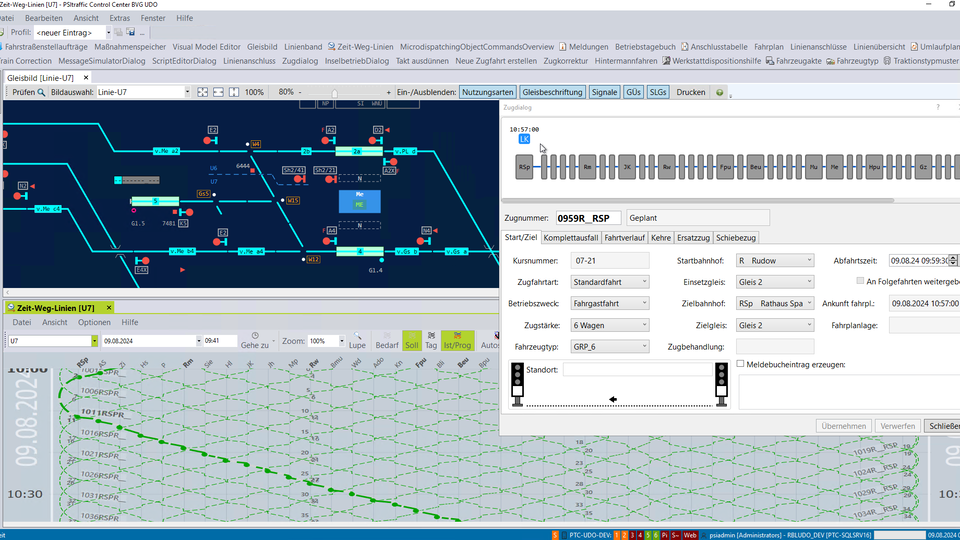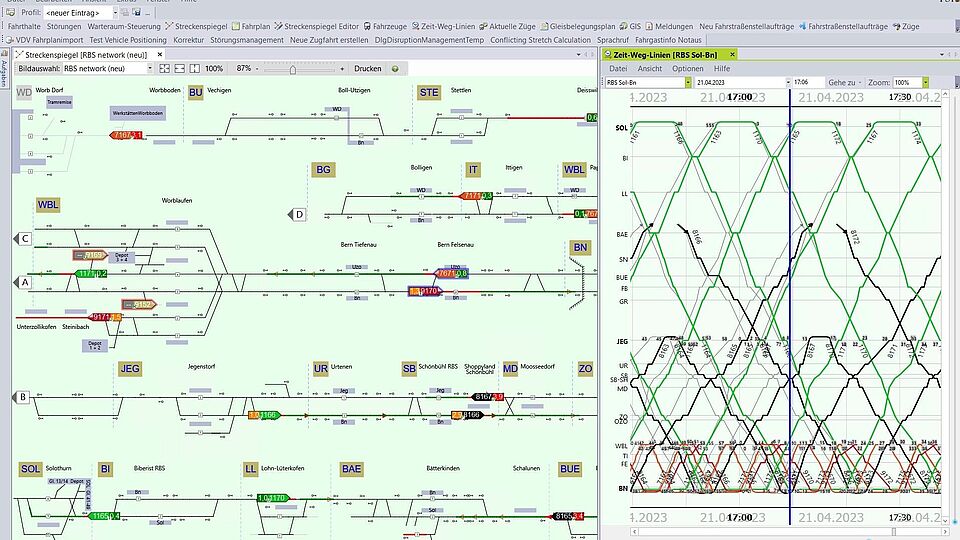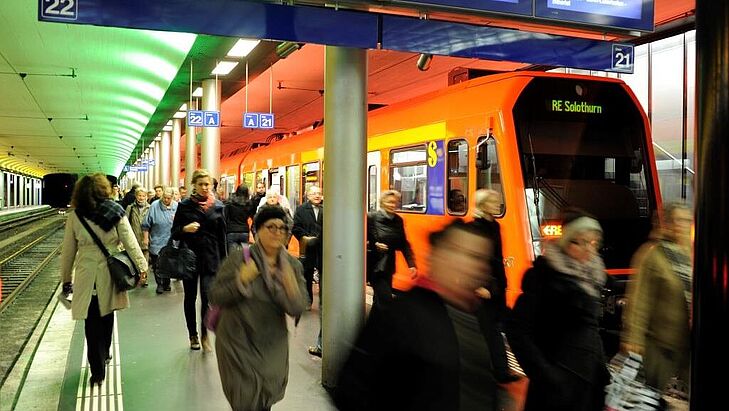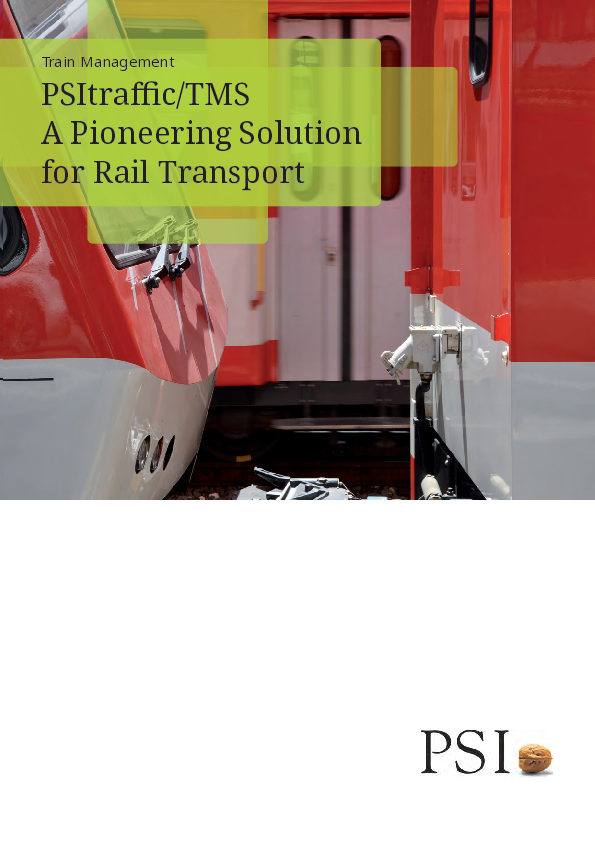
Against the backdrop of a growing world population and increasing mobility needs, but also higher demands on safety, punctuality and modern technical equipment, innovative, networked software systems such as the PSItraffic Train Management System (TMS) are essential.
It is the basis for the digitalization and automation of rail traffic processes and enables safe, trouble-free and economical train operations. PSItraffic/TMS integrates metros and trains in equal measure.
Central monitoring and control of data
The system determines all the necessary data at any time and presents it to the dispatchers in a clear and concise manner. An integrated incident management system ensures that unforeseen events, such as defective points, signaling systems or delays, are detected and processed in real time with appropriate solutions. This enables dispatchers to react as quickly as possible to current disruptions without losing time and to ensure that the planned train operations are established. All data recorded in PSItraffic/TMS also forms the basis for providing passengers with up-to-date passenger information.
Ready for ATO/CBTC ?
With the Train Management System, PSItraffic/TMS provides an important building block for all levels of automation up to fully automated operation.
What has long been a reality in subway railroads is also increasingly coming into focus in long-distance transport due to the increasing digitalization and networking of processes and systems: partially or fully automated train operation (ATO/CBTC). It is becoming increasingly important for the future viability of the railroads, as it underpins key strengths of rail passenger transport, such as reliability, safety, high transport capacity and sustainability.
PSItraffic/TMS collects all operational data and determines optimal train journey profiles, taking into account current conditions and scheduling decisions. These journey profiles are transmitted to the subordinate ATO/CBTC systems. Depending on the expansion stage, this results in journey recommendations for driver assistance systems or fully automated operation of the entire network. Depending on the level of automation, train drivers take on a monitoring function and intervene in the event of disruptions or hazardous situations.
The advantages of partial or full automation:
- Increase in transport capacity due to higher train frequency
- Improved timetable stability and punctuality
- Energy savings through optimized driving style
- Greater passenger comfort thanks to consistent ride quality.
Benefits at a glance

-
Modularity and openness The software modules can be combined, expanded and configured as required. Interfaces to existing systems are based on common industry standards and are continuously adapted.
-
Simple, intuitive operation The user interfaces have a uniform design and are extensively configurable. Specific views can be individually arranged, zoomed or "docked" to the edge of the screen.
-
High degree of automation relieves operator/user Control processes are digitalized and automated across the entire process chain, freeing up personnel resources to focus on incidents and similar special features in the operating process
Features
-
Automatic train steering The system requests the necessary routes via a secure interface (usually interlocking remote control) on the basis of the train movement monitoring data and the defined timetable, thus enabling automatic train control operation. Dispositive interventions in the timetable, such as changes to the routes, are implemented directly in the automatic train control system without any further operating actions.
-
Automatic conflict detection and resolution The data from the system forms the basis for real-time passenger information - in the vehicles, at stations and on mobile devices. Special texts can be recorded for regular operations and for possible scheduling measures, which are automatically selected depending on the operating status.
-
Connection safety devices The system checks in real time whether transfer connections can be maintained. If certain limits are exceeded, the dispatcher is alerted and can act accordingly. Train drivers and passengers are informed automatically.
-
Autonomous train operation PSItraffic/TMS calculates the optimum driving strategy and speed - also taking into account short-term events and updates - and sends the data to assistance systems. These can intervene semi-autonomously or autonomously in operation and thus support the driver in certain situations.
Typical users

Operations manager
The system requests the necessary routes via a secure interface (usually interlocking remote control) on the basis of the train movement monitoring data and the defined timetable, thus enabling automatic train control operation. Dispositive interventions in the timetable, such as changes to the routes, are implemented directly in the automatic train control system without any further operating actions.
-
Ensure availability
Safeguarding circulation and operating processes in compliance with legal regulations
-
Reduce operating costs
Monitor and optimize operating costs
-
Increase in satisfaction
Increase employee and passenger satisfaction and optimize the image of the transport company
References
FAQ´s
Can the train positions be displayed in the network?
Yes, because PSItraffic/TMs can be used to visualize the train timetable. The positions of all trains in the network and their predicted routes can be displayed in real time. This enables dispatchers to react quickly to changes and determine new routes if necessary.
Does the system also support wing train operation?
Yes, PSI Traffic/TMS supports the separation and subsequent merging of combined trains to reach different terminal stations as part of dispatching and passenger information.
Does the operator receive information about the consequences of certain operating actions?
Yes, the operator immediately sees the effects of his planned interventions in the time-distance-line diagram (ZWL). For example, the relocation of a crossing point can lead to delays for other trains or subsequent journeys. These effects are visualized before the timetable intervention is accepted.




